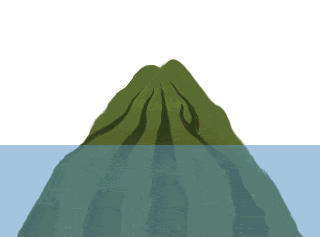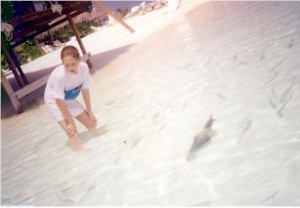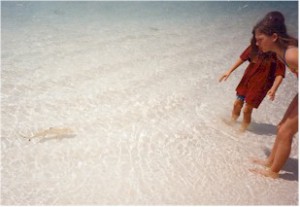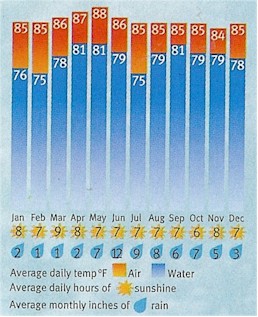Tim Godfrey’s ‘Dive Maldives’ is focused on diving, but also has excellent general history, geography and background. The islands may look like plots of sand with a few palm trees, but they actually have a fair amount of diversity. In the picture above from his book, Godfrey outlines some of the key parts of a Maldive atoll island along with its Dhivehi name which are words you will come across often especially in the names of different places (ie. thila, giri, fary, finolhu, fushi).
Atoll Formation
The defining element and the very essence of the Maldives are the coral atolls. Aesthetically and aquatically stunning geological formations that captivate from the first moments where the long haul jet is coming into the area on arrival. One of the first questions visitors have is ‘what are these things and how did they get here.’
Wikipedia has good article on Atolls and their formation including animation of atoll formation shown above. Britannica also has a similar illustration, but annotated with terms here.
Greetings of the Season
Greetings are always a curious part of any language. The Hawaiians have ‘aloha’ which means ‘hello’ and ‘good bye’ as does the Italians’ ‘ciao’. The English – as in what people in England speak – have an all purpose word ‘cheers’ which can not only be used as ‘hello’ and ‘good bye’, but also ‘thank you’ and ‘you’re welcome’.
Dhivehi is the native language of the Maldives islands and it has no direct translation for ‘hello’ or ‘goodbye’ (http://en.wikipedia.org/wiki/Dhivehi_language). Instead, islanders greet each other with a smile or the raising of the eyebrow and just ask "where are you going?" followed by "what for?" The tradition evoked for me one of the earliest ever Dilbert cartoons show above (featured in Dilbert’s ‘Build a Better Life by Stealing Office Supplies’).
Seasons Greetings!
Maldives for Families
(our children, Isley and Chase, fish watching including ‘wading with the sharks’ – harmless, mini-black tipped reef sharks – on the right)
I had originally thought of creating a web site on the Maldives called ‘Maldives for Families’. It is renowned as a top diving and honeymoon destination, but we found it distinctively suitable for children. The first and foremost appeal is safety. You never really have to worry about them running off or for that matter being absconded because the islands are so small and there is little traffic on an off. If you lose sight of them, you know that they can’t be far because there is not far to go. In fact, in many islands, no one is ever more than shouting distance away.
Of course, the circumpresent water is always a potential danger, but of all fun in the sun beach destinations the Maldives are about as safe as you get. Their unique archipelago topology means than most islands are surrounded by shallow calm lagoons, often protected several metres offshore by a coral reef. This means that there is often very little current and swimming in the ocean is like swimming in a paddling pool (or your own personal aquarium when you consider all of the colourful fish around – always a delight for the children).
Despite the charms of the beach for children, one recommendation I always make to families of all ages is to select a resort with a pool (Resort Finder allows you to filter for Pools). After a while, the salt and sand get aggravating for children and the cleaner more confined pool makes for a crucially refreshing change of pace.
For a fine piece on other aspects to vacationing in the Maldives with children, check out the Sunday Times article “The Maldives: now for children too”.
Air and Water Temperature
People often ask when the best time of year to go to the Maldives is for the best weather. As you can see from the chart above, provided courtesy of Hayes & Jarvis Maldives catalogue, there really is no bad time of year. January through April is the sunniest and driest, but we have visited all year round and have always found the weather consistently brilliant. As you can see from the temperature chart (orange bars), the air temperature average varies a total of 4 degrees between 84 and 88 degree Fahrenheit (29 to 31 degree Celsuis).
One of the luxuries of the distinctive Maldive turquoise lagoons and colourful reefs is the very comfortable water temperature. It makes snorkelling and swimming especially comfortable and reduces the equipment fuss for diving as often one can dive in just a swimsuit and no wetsuit. However, the water temperature does vary a bit more from a low of 75 to a high of 81 Fahrenheit (24 to 27 degrees Celsuis).





